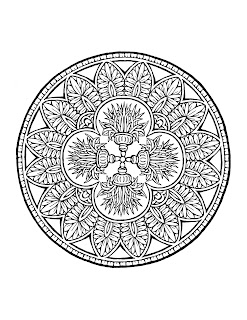Last week I wrote a few blogs, "A Well Performed Savasana" and "Progressive Relaxation", about the feeling of being in the pose and ways to relax in the pose.
So, I thought it fitting to have the May pose of the month as Savasana. A seemingly simple pose, yet can be the most difficult to perform because the body, senses and the mind must remain still, yet as Mr. Iyengar says, the intellect must remain alert.
Below is a general description about how to prepare and come out of savasana. For a more detailed instruction please see B.K.S. Iyengar's,
Light on Pranayama.
Benefits: Helps to release tension, sooth nerves, muscles and joints and refreshes the whole body.
Cautions: If you have hyper-tension, high blood pressure, heart disease or emphysema you should support the back body with a bolster so chest is higher then legs.
If you are pregnant you should also raise the chest with bolsters.
Preparation for Savasana begins with creating a space that is quiet and free from draft.
Have a mat to lie on and a folded blanket or foam block to support the back of the head and neck.
Remove anything that is restrictive like glasses, belts, jewelery and hair elastics.
Sit in the centre of your mat with knees bent and feet together. Feel both sitt bones evenly pressing into the floor. Gently hang onto the back of your thighs and slowly roll down, one vertebra at a time onto the mat. Imagine a line going between the feet, through the centre of the body, neck, chin, nose and forehead.
Keeping the knees bent, gently lengthen the back of the neck and bring the blanket or chip foam block to just touch the tops of the shoulders, support the back of the neck and head. Rest the back of the head right in the center of the back of the skull. Do not let the head fall to either side.
Then pressing the feet into the floor, lift the hips and lower back off the floor and with your hands gently move the back of the waist towards the back of the thighs and release back down. Adjust the back body as needed remaining in a straight line.
Extend and straighten one leg out at a time and keep the legs drawn together. Your body should be in a straight line from heels to head.
On the exhalation let the feet open out to the side so that the pinkie side toes are closer to the floor. If you are tight in the legs you may need to separate the legs further apart.
Pin the inner point of each shoulder blade to the floor, move the lower shoulder blades into the body and extend the arms out to the side with the palms facing up. Allow the thumb side of the hand to move closer to the floor then the pinkie side. If you are tight in the shoulders and back you may need to bring the arms further away from the side body. Keep the palms and fingers relaxed.
Once released onto the floor ensure that the back rests evenly on the mat with the dorsal and lumbar areas of the spine even and the ribs spread out uniformly. Scan the body for any remaining tension and release. Make sure the head is not tilting back, which is stimulating to the brain but allow the skin of the forehead to remain parallel to the ceiling. Turn the eyes to look inward and down to the heart centre. Keep the sense organs drawing inward, shrinking away from the outer body. Keep the breath smooth and even.
If you have any lower back pain or lordosis of the back you may wish to place a bolster under the back of your thighs. Make sure the legs are spaced evenly apart.
To come out of the pose slowly begin to bring awareness to the body, breath and mind by gently moving the fingers and toes, roll the arms and legs, hips, neck and head. Bend the knees one at a time and raise the right arm up by the right ear.
Keeping the chin drawn into the chest roll to the right side using the arm as a pillow. Stay for a few breaths or a few minutes, keeping the brain cool and relaxed. On the inhalation press the floor to come up to sitting, raising the head last.
End in a seated pose to give gratitude to this great gift of yoga.
Namaste.
Pamela Nelson









































